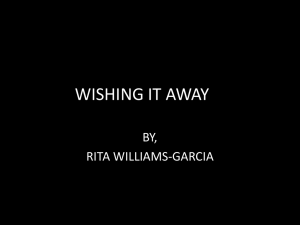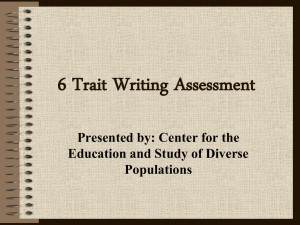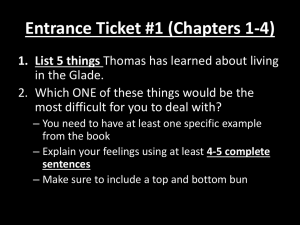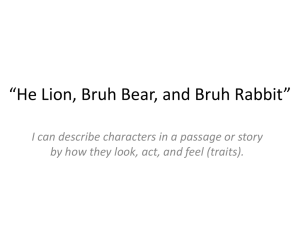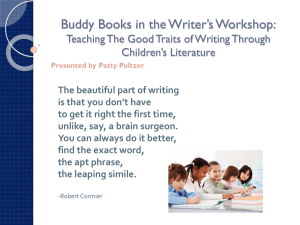Basic Six Traits in the primary grades - ESU6Writing
advertisement
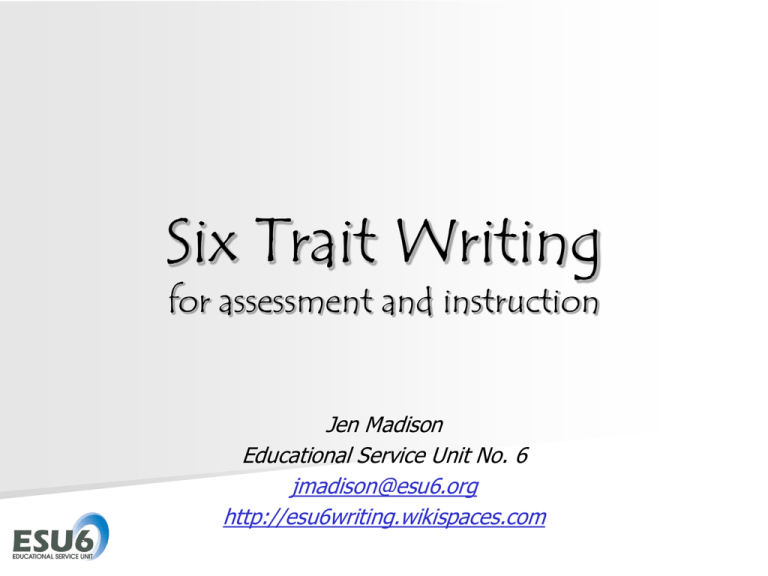
Six Trait Writing for assessment and instruction Jen Madison Educational Service Unit No. 6 jmadison@esu6.org http://esu6writing.wikispaces.com Agenda Welcome! Introducing the Traits – What Makes Writing Work? – Qualities of Writing Using Rubrics and Student Papers Trait by Trait – Language of the trait – Scoring student work – Teaching and learning activities What makes writing work? Record one specific characteristic of good writing. Musical Cards – Trade cards while the music plays. – When the music stops, partner with the person currently trading with you. – Read each card and together distribute 7 points between importance and What makes good the two cards to represent the degree of relevance toward the question: writing work? THE 6+1 TRAITS Ideas The heart of the message Organization The internal structure of the piece Voice The feeling and conviction of the writer Word Choice The precise language chosen to convey meaning Sentence Fluency The rhythm and flow of the language Conventions The mechanical correctness Presentation How the writing looks on the page Purpose of Traits “an answer to the question: What makes writing work?” consistent “writer’s language that opens the door to revision” (a how to for revision) a way to – – – – organize and clarify good writing instruction encourage consistent assessment empower and motivate young writers encourage thinking skills and self-monitoring NOT meant to replace instruction of writing process! (Spandel, Creating Writers, 2005, p. 1-2) Trait-based Writing Form and language Vision of success “If we had called them the six keys to good writing, people likely would have made the instructional connection immediately. This is where the true power of trait-based instruction lies— showing students the keys to writing well.” Spandel, V. (2008). Creating Young Writers “…the keys to writing well:” Have a strong, clear idea. – Use details and pictures to paint a picture in year reader’s mind. Write with authority and voice. Organize your information so that a reader can follow it. Use words that make sense—and that are lively as well. Write with fluency and variety—the way good dancers dance. Make your conventions as strong as you can so that readers can figure out your message. (Spandel, 2008, Creating Young Writers, p. 7) Agenda Welcome! Introducing the Traits – What Makes Writing Work? – Qualities of Writing Using Rubrics and Student Papers Trait by Trait – Language of the trait – Scoring student work – Teaching and learning activities What do you notice? • • • • • • • • • I can just see it. I feel like I’m in that car. I love the line “her eyes were as big as her fists.” He’s having a good time [most readers assume the writer is male]. I know these people. Lively! I sympathize with Mom-- I hate mice too! I like the pickle jar-- I can even smell the pickles. Great images-- love Dad backing into the tree and mom in her nightgown. You get every point of view- even the mouse’s! What do you notice? Boring-- it put me right to sleep. Flat, empty. Safe. She was writing just to get it done. Mechanics are pretty good. It doesn’t say anything. The organization isn’t too bad. What Redwoods? The title doesn’t go with the paper. She (he?) seems like a nice kid- I want to like it. It’s not that bad for fourth or fifth grade-- I assume that’s what it is right? Rubrics and Scoring Guides a few ideas A Developmental Continuum for Early Writing – Pre-K to K – K-2 – Ruth Culham, http://www.culhamwriting.com/lib rary.html K-2 Illustrated Beginning Writer’s Rubric – Pre-K to 2 (or until student consistently scores 5 or 6) – Education Northwest, 2010 6+1 Traits Condensed 5Point 3-12 Writer’s Rubric (“One-Pager”) – 3-12 – Education Northwest, 2010 My First Scoring Guide (Student-Friendly Scoring Guide Primary) Student-Friendly Scoring Guide Grades 3-5 – Ruth Culham, http://www.culhamwriting.com/lib rary.html Exploring the Traits Through Student Writing Read the proficient level descriptions for ideas/content – Note the words that best define the trait characteristics (the criteria) and proficiency levels. Read the writing thoroughly: – Look for strengths – Score traits – Discuss reasons for your score(s) Holistic vs. Analytic Scoring Holistic Analytic Each trait scored separately One overall score Provides more detailed feedback to guide instruction and monitor progress Intended to generalize overall effect Cannot provide specific, needsbased feedback Usually reserved for summative assessment (after instruction and practice) Used for most classroom practice and formative assessment (during instruction and practice) Using Rubrics: One Way to Respond & Assess Many formats and varieties – Thoughtfully select traits for assessment informational/technical writing creative/personal writing – Have students help create indicators – Provide student friendly versions – Engage students in activities using rubrics – Be consistent – Score certain traits Using Rubrics One Way to Respond & Assess Always read the entire paper first Refer to the scoring guide often Stronger or weaker? Score each trait separately Remember: – 1 indicates beginning performance, not failure – top score represents strengths and proficiency, not perfection Watch out for rater bias Objectivity Issues and Sources of Bias Physical characteristics Personal reaction to particular tones, content, or students Length Positive-negative leniency – Tendency to be too hard or too easy on everyone Fatigue Skimming Sympathy “Self-scoring” – Score the writer’s work, not your skill of putting the puzzle pieces together. Objectivity Issues and Sources of Bias Sources of rater bias – Pet peeves, such as…. – – – – – – – – Big LOOpy writing (with stars and hearts) Teeny, tiny writing Writing in ALL CAPITALS Tons! Of exclamation (!!!) points!!!! Mixing it’s and its The End (like I couldn’t tell) Total absence of paragraphs What’s one of your pet peeves? Using Rubrics More opportunities – – – – – – Create with students School-wide Collect anchors/samples Subject or genre specific Student self-assessment submitted with writing Some traits e.g., always ideas & conventions, randomly select one other A note about grading… Focus on feedback – Recognizing improvements & strengths (to replicate) – Providing appropriate instruction & challenges Translating to grades…be careful! – Be certain that the percentage you assign is appropriate for the rubric rating! 3 4 3 3 5 3 = 21/30 = 21/6 (#of criteria) = 70% = 3.5 or 85% YIKES! MORE APPROPRIATE Raw Avg. % 5 100 4 90 3 80 2 70 1 60 + 1% for each additional .1 Agenda Welcome! Introducing the Traits – What Makes Writing Work? – Qualities of Writing Using Rubrics and Student Papers Trait by Trait: IDEAS – Language of the trait – Scoring student work – Teaching and learning activities IDEAS: Look for the following… Clarity and Focus of the Content Rich and Vivid Details Clear Sense of Purpose Accuracy Fresh and Original Thinking Quality not Quantity “Too many scoring systems reward students for including merely more arguments or examples; quantity is not quality, and we teach a bad lesson by such scoring practices.” -Grant Wiggins Exploring the Traits Through Student Writing Read the proficient level descriptions for the trait – Underline/highlight the words that best define the characteristics of proficient – Mark (?) descriptors requiring clarification Read the writing thoroughly: – Look for strengths – Score each trait – Prepare to discuss reasons for your score Ideas Lesson Ideas Take Out the Details – Take the details out of a known story. – “What’s missing? What makes the original better?” Graphic Organizers – Make expected content explicit – Model transfer from organizer to writing Snapshot – “I want to see it, like a photo in an album.” – What would I see if I would “zoom in” on this part? “Don’t say the old lady screamed. Bring her on and let her scream.” --Mark Twain Teach the Genre – How do writers express the main idea? – How do they support the main idea (e.g., characterization, examples, explanation, facts, logic, sensory details)? Teaching the trait of Ideas Talk about where ideas come from. Model differences between generalities and good details. Read aloud from books with striking detail or strong imagery. Use questions to expand and clarify a main idea. Agenda Welcome! Introducing the Traits – What Makes Writing Work? – Qualities of Writing Using Rubrics and Student Papers Trait by Trait: ORGANIZATION – Language of the trait – Scoring student work – Teaching and learning activities ORGANIZATION: What to look for… Enticing Lead Sentence – The first sentence and introduction should be engaging. Thoughtful Transitions – One paragraph should set the scene for the next paragraph. Logical Sequencing – There is a systematic approach to exploring topic. Controlled Pacing – Details are provided in the right amounts. Satisfying Conclusion – The piece should have meaningful ending. Exploring the Traits Through Student Writing Read the proficient level descriptions for the trait – Underline/highlight the words that best define the characteristics of proficient – Mark (?) descriptors requiring clarification Read the writing thoroughly: – Look for strengths – Score each trait – Prepare to discuss reasons for your score Organization Study Logical Order – Separate sentences/paragraphs from a writing – Ask student to put classify them, put them in order, and identify key phrases. Compare Leads or Endings – Find different examples in children’s books, content text, your own (not so great) examples, brainstorm examples with students. – Which do you like best? Why? – Host a “Bad Leads Awards Ceremony.” Teach transition and signal words appropriate for the type of writing. Lesson Ideas The shark’s jaw is located back beneath his long snout, but this does not prevent him from biting directly into the flesh. When he opens the jaw, the lower jawbone is thrust forward while the snout is drawn back and up, until it makes almost a right angle with the axis of his body. At this moment, the moth is located forward of the head and no longer beneath it. It resembles a large wolftrap, equipped with innumerable sharp and gleaming teeth. The shark plants this mechanism in the body of his victim and uses the weight of his own body in a series of frenzied convulsions, transforming the teeth of the jawbones into saws. The force of this sawing effect is such that it requires no more than an instant for the shark to tear off a splendid morsel of flesh. When the shark swims off, he has left a deep and perfectly outline hole in the body of his victim. It is terrifying and nauseating to watch. (from Jacques-Yves Cousteu, The Shark: Splendid Savage of the Sea, p. 37) Agenda Welcome! Introducing the Traits – What Makes Writing Work? – Qualities of Writing Using Rubrics and Student Papers Trait by Trait: VOICE – Language of the trait – Scoring student work – Teaching and learning activity Statewide Writing Assessment VOICE: Look for the following… Expression of individuality Reader wants to keep reading Commitment to the topic Suits the audience Fits the purpose Voice Creative Writing – Feelings – Enthusiasm – Individuality – Passion Technical / Research Writing – Perspective – Level of Formality – Level of Objectivity Voice is often the reason I read! Voice in Informational writing “If we were randomly inserted into the Cosmos, the chance that we would find ourselves on or near a planet would be less than one in a billion trillion 33, a one followed by 33 zeroes). In trillion (10“The Cosmos is a very big place.” everyday life such odds are called compelling. Worlds are precious [1980, p. 5].” Confident Knowledge-driven Inspiring Exploring the Traits Through Student Writing Read the proficient level descriptions for the trait – Underline/highlight the words that best define the characteristics of proficient – Mark (?) descriptors requiring clarification Read the writing thoroughly: – Look for strengths – Score each trait – Prepare to discuss reasons for your score Voice Lesson Ideas Write voice IN or OUT – Take the voice out of a passage and have students put their own in. Bored vs. Excited? – What do these look like? (Students demonstrate kinesthetically.) – “I want to see an ‘excited’ face in my mind when I read your writing.” – Show them two sample paragraphs using the same facts. Which was written by an “excited” writer? How can you tell? Read aloud from works that have strong voice. Help students identify an audience. Agenda Welcome! Introducing the Traits – What Makes Writing Work? – Qualities of Writing Using Rubrics and Student Papers Trait by Trait: WORD CHOICE – Language of the trait – Scoring student work – Teaching and learning activities Word Choice: What to look for memorable words and phrases accurate use of words awareness of different ways to say things appropriate choices for the purpose and audience not inflated or overused Exploring the Traits Through Student Writing Read the proficient level descriptions for the trait – Underline/highlight the words that best define the characteristics of proficient – Mark (?) descriptors requiring clarification Read the writing thoroughly: – Look for strengths – Score each trait – Prepare to discuss reasons for your score Word Choice Lesson Ideas Study connotation (subtleties of word variation) – Put related words on a continuum – said, whispered, barked, exclaimed, shouted, screamed, commented murmured, declared, mentioned, hollered – Apply movement to variations of verbs & discuss differences Trash overused words & display interesting, lively, or content appropriate words – Use wall displays, bulletin boards, etc. – Brainstorm appropriate alternatives. Show students examples of writing in your content and together analyze words. – Identify specific nouns and strong, active verbs – Identify powerful, meaningful words – Rate level of formality and objectivity Agenda Welcome! Introducing the Traits – What Makes Writing Work? – Qualities of Writing Using Rubrics and Student Papers Trait by Trait: SENTENCE FLUENCY – Language of the trait – Scoring student work – Teaching and learning activities Sentence Fluency: What to look for Rhythm and flow Varied sentence structure – Length – Beginnings Reading ease…not just punctuation Sentence Fluency Chart # of words first 3 words Analyze the mode, genre, author’s style: How long are sentences? How do sentences begin? What kind of verbs are prevalent? What kind of sentences are used? What is the purpose of each sentence? Exploring the Traits Through Student Writing Read the proficient level descriptions for the trait – Underline/highlight the words that best define the characteristics of proficient – Mark (?) descriptors requiring clarification Read the writing thoroughly: – Look for strengths – Score each trait – Prepare to discuss reasons for your score Sentence Fluency Lesson Ideas Read fluent passages out loud – “Do you like the way this sounds? – “How many different ways does this writer begin sentences?” – “Describe the lengths of the sentences. What effect does this create?” Mentor Sentences – Collect powerful sentences to use as models of specific techniques – (prepositional phrases…a strong way to add detail) “Over bushes, under trees, between fence posts, through the tangled hedge she swoops untouched” (Davies, 2004, p. 12). Chart expert and student writing fluency – Analyze a passage for sentence lengths, beginning variety, and other characteristics. Agenda Welcome! Introducing the Traits – What Makes Writing Work? – Qualities of Writing Using Rubrics and Student Papers Trait by Trait: CONVENTIONS – Language of the trait – Scoring student work – Teaching and learning activities Your students should ask… (beginning writers) Did I leave spaces between words? Does my writing go from left to right? Did I use a title? Did I leave margins on the sides? At the bottom? Did I use capital letters? Why? Did I use periods? How about question marks? Did I do my best on spelling? Could another person read this? Your students should ask… (more mature writers) Have I used fragments or run-ons only for a conscious effect? Do I have agreement (subject-verb, pronounantecedent, etc.) Does my punctuation accurately guide the reader? Have I used the correct spellings for homophones? – Their/there/they’re Is the format appropriate? (Does it meet the expectations of the audience?) Have I cited sources appropriately? Exploring the Traits Through Student Writing Read the proficient level descriptions for the trait – Underline/highlight the words that best define the characteristics of proficient – Mark (?) descriptors requiring clarification Conventions Lesson Ideas Teach & model (I do it. We do it. You do it.) – – – – Editing marks Editing with text that’s not their own Editing their own before publishing with scaffolding Process for spelling a word (i.e., spell it the way it sounds, look it up, ask someone else) Demystify Students: display, explain, and provide alternatives for your pet peeves Focused Peer Editing – “Circle all of the second-person words (i.e. you, your). Help your partner find two alternatives for each.” What do you know about the traits? A. Ideas / Content B. Organization C. Voice D. Word Choice E. Sentence Fluency F. Conventions Modeling and Examples Write with your students! – – – – Live writing Think-aloud Allow students to contribute to revision decisions Exaggerated writing Use appropriate literature – Passages from known literature – Make the text visual Use student writing – Stress strengths, specific skills/craft techniques Strategies for Better Instruction TEACH the language to speak and think like writers. MODEL specific craft techniques. – Name it. Describe it. Explain why it’s good. READ, SCORE, and JUSTIFY scores on anonymous sample papers. Provide focused PRACTICE for REVISION. WRITE. (Yes, you.) READ and DISCUSS strengths and weaknesses in all kinds of writing. DEMYSTIFY writing in your class. Provide thoughtful, effective PROMPTS Recognizing Craft Techniques: One Way to Respond Be a collector of the recognizable, replicable, small things that effective writers do. Example or Description Specific Craft Why is it good? I was sad. inside sentences reader can understand how the author feels boats, trains, airplanes, and cars using commas in a series reader understands that items are separate Band-Aid box brand name gives an extremely details image in only a few words; can also evoke familiarity or nostalgia Hale, Crafting Writers K-6, 2008 R.A.F.T.S: a way to prompt Role of the writer – Audience – helps writer organize ideas and employ format conventions for letters, interviews, story problems, and other kinds of writing Topic or subject – reminds writer he/she must communicate ideas to someone else: helps determine content and style Format of the material – helps writer decide on point of view and voice. helps writer zero in on main idea and narrow the focus Strong verb – directs writer to the writing purpose, e.g. create, defend, analyze, persuade, evaluate, etc. Building R.A.F.T.S. Use writing to help students explore a concept from different perspectives and through different formats. – Role – Audience – Format – Topic – Strong Verb More Examples: – You are a vegetable plant in a garden. Write a letter to the sky to explain why you need rain and sunshine. – You are a semicolon. Write a journal entry to a student writer beginning with “I wish you understood where I really belong.” – You are a kidney in the human body. Write a letter to your host to explain what you need to stay healthy and why the host will be better off if you ARE and STAY in tip-top condition. A Few Resources Northwest Regional Laboratory (NWREL). (2007). 6+1 Trait Writing. Retrieved October 2008 from http://www.nwrel.org/assessment/department.php?d=1. Spandel, V. (2008). Creating young writers: Using the six traits to enrich writing process in primary classrooms. Boston: Pearson, Allyn and Bacon. Spandel, V. (2005). Creating writers: Through 6-Trait Writing Assessment and Instruction. Fourth Edition. Boston: Pearson, Allyn and Bacon. Two Stars & a Wish Please record two of the most important and/or relevant ideas you heard. Please record something you wish about this session.
